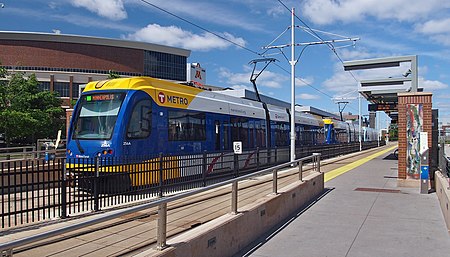Stadium Village station
2014 establishments in MinnesotaMetro Green Line (Minnesota) stations in MinneapolisMidwestern United States railway station stubsMinnesota building and structure stubsMinnesota transportation stubs ... and 1 more
Railway stations in the United States opened in 2014

Stadium Village is a light rail station on the Green Line on the University of Minnesota campus in Minneapolis. It is located east of 23rd Avenue Southeast between University Avenue and 4th Street, across the road from Huntington Bank Stadium and a short distance south of the University of Minnesota Transitway.East of this station, the rail line parallels the transitway until 29th Street SE, where it turns towards University Avenue. Construction of the line along the transitway began in 2011, with construction of the station starting in 2012. The station opened along with the rest of the line in 2014.
Excerpt from the Wikipedia article Stadium Village station (License: CC BY-SA 3.0, Authors, Images).Stadium Village station
Southeast University Avenue, Minneapolis
Geographical coordinates (GPS) Address External links Nearby Places Show on map
Geographical coordinates (GPS)
| Latitude | Longitude |
|---|---|
| N 44.974722222222 ° | E -93.222916666667 ° |
Address
Stadium Village
Southeast University Avenue 2301
55414 Minneapolis
Minnesota, United States
Open on Google Maps










